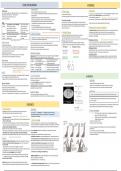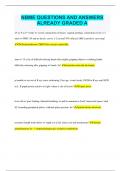EVOLUTION:ORIGIN EVIDENCE
EVOLUTION
Giraffes(wrong) 1) universe started 13,7 bya, Earth is 4.6 by old 5. Embryology 3. Genetics
•∆ in env e.g. droughts-> less foliage lower down so adv to eat foliage higher up 2) e's crust built up in layers[laid down by sedimentation(water)/volcanic activity, 1. shows all orgs descended from common a-> all org have RNA+DNA, many genes in living
•dvped need to eat f higher up .˙. stretched necks =study of vertebrate embryos
oldest @bottam) org encoded to make identical proteins e.g. enzymes for cellular r.
•stretching+dvp of muscles+bones in neck e.g. all embroys have gill slits, fish-like heart, tail and nerve cord(bcms spinal cord)
3)dating of fossils [relative+radiometric/absolute dating) 2. shows relatedness amongst org fewer shared- more distant rel+further in past diverged
passed on to offspring [more sequences on DNA shared, closer rel btw 2 spps+more recently diverged from c.a.]
4) atleast 5 mass extinctions have occured with many species bcm extinct 1. Comparitive embryology:
5) by studying fossils one learns about ancient forms, (extinction) early embryos of very diff orgs closely resemble each other[sim structure]
-1900: *humans and chimps share approximately 98% of the same DNA
->understand life forms ∆ gradually, evidence to support idea species ∆ -with further dvp of the embryo, the fish-like features are lost+embryos bcm less -
Charles 5 yr expedition, Snth hem, HMS Beagle 1859: Origin of Species 6) SA is very rich in fossils
Darwin -aware of diversity among -Descent with mod similar, taking on charactertics of vertebrate group to which they belong
orgs,variation of indv of same -Natural selection
e.g. stromatolites(Barberton)fomed layers blue-green algae
coelocanth, mammal-like reptiles Karoo, earliest ancestors[Homo ergaster]
-evidence of common a 4. Comparitive anatomy evidence
species,distribution of diff s [mech © evo. ind best 1. comparitive anatomy:compare external+internal structures - how closely related 2 orgs
-Principles of Geology: Charles Lyell traits survive] unifying concept acts as foundation for understanding all bio 6. Vestigal Organs - homologies may be acquired from a common a, thus on same evolutionary line
Alfred Brit naturalist, accepted concept of evo - distri of species on 1.what is evolution =structures or organs that seems to be stunted +have no function
3. no. of shared homologous features btw 2 spps shows how recently those 2 spps
Russel -worked in Malay archipelago island vs mainland diverged from shared lineage
biological evo: the change in gene pool of a population over time by processes such *often homologous organs that are useful in other species
Wallace (Wallace's line) -isolation - orgs with vestigial structures must have shared a common a with orgs in which the
geology, biogeography, fossils as mutation, natural selection and general drift Homologous structures: flippers of whales+legs of horse same structure diff function
homologous structure is functional
= similar in funsamental structure, position+development, superficially diff
Charles Darwin •all living org descended from common ancestor[single origin of life] e.g. cave fish blind but still has eyes, appendix, pelvic girdle in dolphin
>evidence of divergent evolution, all a share a common ancestor that had the same bones
1) Descent with modification *diversity of life result of ∆s in pops. over millions of years[descent with modification] e.g. tailbone in humans, homologous to functional tale of other primates
e.g. pendatactyl limb vertebrates[all shared common a same bones]
Common a->spread into a variety of habitats->bcs already adapted to new local *new species arise fro pre-existing species
cond, survived-> passed traits onto offspring->diversified into new species(my) ( all life shares same genetic code+similar basic enzymes)
Analogous structures
->some species died out ie bcm extinct -superficially similar structure as evolved in sim env, perform the same/similar function
2)Diversification by branching fundamental structure diff .˙. do not share a recent common a
ancestroal sps gave rise to 2+ new relaties sps, each in a new habitat
theories of evolution e.g. butterflies and birds
*before 1700: species were unrelated+remained unchanged+earth young+static(6000) -evidence of convergent evolution ie analogous[ very little in common besides function]
some sps died out ie bcm extinct(evident in fossil record)
-1800: D+L challenge concepts [studied fossils+aware of huge diversity] structures evolve along diff ev paths from diff a to perform same function in a part. env
Erasmus Charles' grandfather life on E descended from1800
1700-early common a
Giraffe example Darwin Brit dr- philospher+ scientist -species have ∆ed over time
•genetic variation in giraffe pop-some giraffes have longer necks than others
Book: Zoonomia(1794) -no mechanism provided
•env change/competition © shorter-necked giraffes to die+long neck survive
Jean- French naturalist species not fixed[∆ to survive new env]
•n.s. occured: genes for longer necks were inherited by future generations
diff features were favoured in diff env
Baptiste Book: Philosophie *use+disuse of char. [larger+stronger]
diff pop bcm modified+diversified into new sps over time Lamarck Zoologique (1809)- ->acquired traits passed on to offspring
diversification- some died out *both blvd species have common a, evoltion occured as species adapted to their env
Alfred
1. D+W read An Essay on the Principle of Pop.
diff pop Thomas Malthys(1797)\2. competition
bcm modifie
in pop-> struggle for existence btw members in pop
.Lamark Explanation
Hypothesis: inheritance of acquired characteristics
evolution
2. indp get idea for natural selection[sent paper, 1858 joint paper, 1859- book]
1) Use+disuse of body parts:
env ∆ed, ;use a body part-> gets larger, don't use->gets smaller
Evolution
Natural selection 2) inheritance acquired characteristics: -explains biodiversity through time[is theory]
*ANy variation in an org that favoured its survival in part env wld increase chance of physical(phenotypic) ∆s acquired by parents passed on offspring, *evolution is a well-established fact-> support by many lines of evidence
reproducing+have fertile, viable offspring pop changed->new species formed *Darwin's ideas correct but mech of evolution only partly understood
*org less favourable variatinoons-less successfull
* more favourable variations(genetically dtm) are transfered to future gen Scientific theory
Faults in his theory
*over time- no. of variations within indv of species incr so much new species result • env does cause phenotypic changes, do not © evo. ∆ sci theory: a thorough explanation supported by lots of reliable evidence as proof
•acquired characteristics are not inherited-> don't change DNA or gametes
scientific hypothesis: idea/ possible explanation about something observed that
answers a question
EVIDENCE =general explanation of an nb natural phenomenon with a reliable bd of evidence that has
dvlp through extensive+repeated observations+experiments to support it
2. BIOGEOGRAPHY EVIDENCE
*biogeography: study of past +present distribution of world's many species Science and Religion
1.fossil records. |. 2. biogeography. | 3. DNA(genetics)+molecular biology
*very diff p+a species in regions of same lat with sim climate, • Science: deals with the material world, investigates physical+natural
4.Homologies+comparitive anatomy |5. Embryology. | 6..Vestigal organs|
aspects of life using scientific method
marsupials(pouches)+monotremes(egg- laying mam) 7. Biodiversity |8.Physiology
1. marsupials vs placentals • Religion: deals with strongly held beliefs, morals, atitudes+spiritual,
[large indig mammals in Ausi region all marsupials vs all other biog region=placentals] philosphical+ethical 'why' q
2. Africa vs South America 1. FOSSIL EVIDENCE -cannot be used to test each other
[SA-neotropical+africa-afrotropical biog r virt identical climate but very diff animals *evidence of systematic evo. ∆ ie evidence for micro+macro-evo[regular change] -complemntary rather than antagonistic
.˙. env cannot account for dis/similarity since sim env can -entirely dif species groups * bias: very few indv bcm f, hard bd org more likely to f, most f aquatic a, not discovered
3.different species of flightless birds/ratites *evidence of descent with modification e.g. dvp of modern horse[no reversals found] 1. Science is ongoing process while religion is open to moral, ethical+philsophical
[Ratites: rheas in S Am, ostriches in Africa, emus in Australia] interpretations
*3 diff species all originated from own ancestor, as common f.b. cld not fly across ocean 1. incr in complexity:oldest rocks, simplest fossils-> youngest rocks human anc 2. science does not claim to know everything
4. diff collection of p+a in regions same latitude, similar climates+conditions 2. incr in diversity: 3.science can explain how life developed through evolution but cannot explain the
Old World +new world monkeys[N: flat face, wide nostril vs O: long snout, close nostril] -Cladogenesis: branching descendents->biodiversity increases mystery of how life started
clustering pattern of closely allied species
*novelties/key innovations- new+original adaptation often -> new genera+species occ
DARWIN 3. more extinct species as one moves back in time(99% org extinxt-not adapt, natural)
1.closely related species located nearby- similar species descended from common a New spps better adapted survive->replace+fill vacant niches(spss not fixed, ∆ +evolve)
2. similar env can contain entirley dif species groups- desc. from a that were diff 4. existence of intermediate forms btw species(transitional/link fossils)
3. oceanic islands *transitional fossils: mixture of traits show link btw groups 'missing link'
- although species sim to each other, diff slightly on each island *evidence of modification by descent[one group given rise to another]
- species livings on islands more closely related to species living on nearest mainland, e.g.mammal-like reptiles(abundantly in karoo) intermediate btw reptiles+mammals
even though diff env, compared sps from other island groups
5. overall incr in size: starting pt tiny unicellular org
4. extinct species closely resembled living in same region-
modern sps replaced+evl into fossil forms[ground sloth+living 2-toed tree sloth]
5. .˙. 2 diff groups of orgs must have arisen by descent by modification from diff Cambrian explosion: 545 mya rapid diversification over rl short period -app huge
ancestors on each side of line diversity of complex, multi-celled orgs
*today estimated 1.4 to 1.7 m species of org
Wallace line: imaginary line bisects Malay archipelago from N-W and SE parts
[each part diff group of living orgs:deep seaways prevented migration btw islands] <- mockingbird species Galapagos islands:diff spps of m on each island. Spps were closer
in app to those on mainland than anywhere else in world





